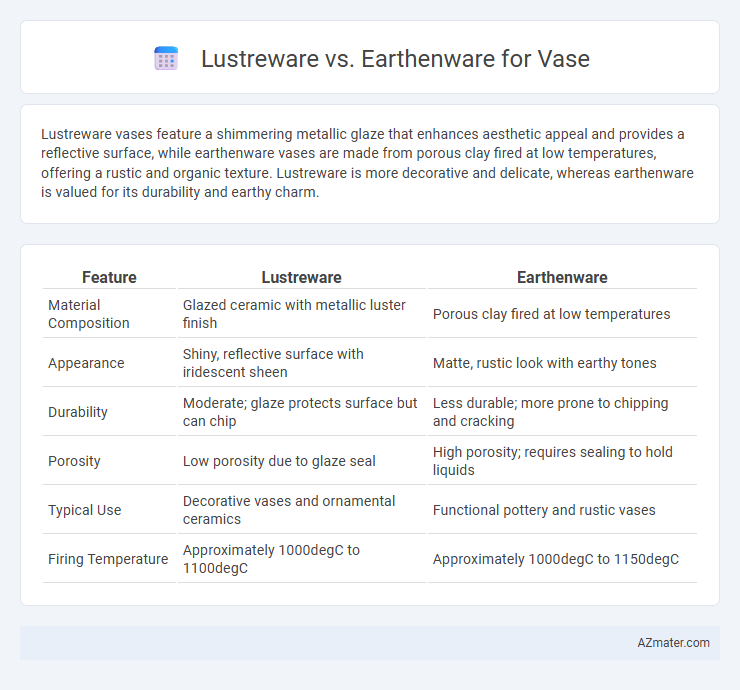Lustreware vases feature a shimmering metallic glaze that enhances aesthetic appeal and provides a reflective surface, while earthenware vases are made from porous clay fired at low temperatures, offering a rustic and organic texture. Lustreware is more decorative and delicate, whereas earthenware is valued for its durability and earthy charm.
Table of Comparison
| Feature | Lustreware | Earthenware |
|---|---|---|
| Material Composition | Glazed ceramic with metallic luster finish | Porous clay fired at low temperatures |
| Appearance | Shiny, reflective surface with iridescent sheen | Matte, rustic look with earthy tones |
| Durability | Moderate; glaze protects surface but can chip | Less durable; more prone to chipping and cracking |
| Porosity | Low porosity due to glaze seal | High porosity; requires sealing to hold liquids |
| Typical Use | Decorative vases and ornamental ceramics | Functional pottery and rustic vases |
| Firing Temperature | Approximately 1000degC to 1100degC | Approximately 1000degC to 1150degC |
Introduction to Lustreware and Earthenware
Lustreware is a ceramic glaze technique that produces an iridescent metallic sheen on pottery, often achieved by applying a thin layer of metal oxides and firing in a reduced oxygen atmosphere. Earthenware, on the other hand, is a type of porous, low-fired ceramic made from natural clay, typically fired at temperatures between 1,000degC and 1,150degC, resulting in more fragile but decorative pottery. When considering vases, lustreware offers a unique glossy and shimmering finish, while earthenware provides a rustic and earthy aesthetic with greater porosity.
Historical Origins and Evolution
Lustreware originated in the Islamic world around the 9th century, featuring metallic glazes that create a shimmering effect, while Earthenware dates back to prehistoric times, crafted from porous clay fired at low temperatures. Lustreware evolved through trade routes to Europe, particularly flourishing during the Renaissance, whereas Earthenware maintained its utilitarian role in everyday pottery across various cultures. The distinct techniques and cultural significance of Lustreware and Earthenware highlight their divergent historical paths in vase production.
Material Composition and Manufacturing Techniques
Lustreware vases feature a metallic glaze composed of silver or copper coatings applied over a ceramic base, creating an iridescent finish through a complex firing process involving reduction atmospheres, while earthenware vases are crafted from porous clay fired at lower temperatures, resulting in a more porous and fragile material often coated with alkaline or lead glazes. Lustreware manufacturing involves multiple firings and precise temperature control to achieve the reflective surface, whereas earthenware is typically shaped and fired once, emphasizing earthy textures and traditional glazing methods. The distinct material compositions and firing techniques directly influence the durability, appearance, and value of each vase type.
Distinctive Visual Characteristics
Lustreware vases are distinguished by their iridescent glaze, which creates a shimmering, metallic finish that changes color when viewed from different angles, offering a vibrant and reflective surface. Earthenware vases, in contrast, exhibit a more matte or satin finish with natural, earthy tones due to their porous clay body and typically feature hand-painted or rustic designs. The reflective quality and multi-hued sheen of lustreware make it visually striking compared to the warm, subdued appearance of traditional earthenware.
Durability and Functional Qualities
Lustreware vases offer a unique iridescent glaze that enhances their decorative appeal but generally exhibit lower durability compared to earthenware, which is known for its robust, porous composition and greater resistance to chipping. Earthenware vases are more functional for daily use due to their sturdier material and ability to withstand impacts, whereas lustreware is primarily valued for aesthetic qualities and may require careful handling. Choosing between these ceramics depends on whether the priority is long-lasting functionality or ornamental elegance in vase design.
Artistic and Decorative Appeal
Lustreware vases exhibit a unique iridescent glaze that enhances light reflection, creating a striking, shimmering surface ideal for artistic statement pieces. Earthenware vases, with their matte and rustic textures, offer a traditional charm that appeals to collectors seeking organic and handcrafted decorative elements. The contrasting finishes make lustreware more suitable for modern, sleek interiors, while earthenware complements earthy, vintage aesthetics in home decor.
Maintenance and Care Requirements
Lustreware vases require delicate maintenance due to their iridescent glaze, which can be damaged by abrasive cleaners or harsh chemicals, thus gentle hand washing with mild soap and soft cloth is recommended to preserve their sheen. Earthenware vases, being more porous, need careful handling to avoid water absorption that can cause staining or cracking, making a sealant crucial for long-term durability in moist environments. Both types benefit from avoiding sudden temperature changes and being displayed away from direct sunlight to prevent fading and structural damage.
Cost and Market Value Comparison
Lustreware vases typically command higher market prices due to their unique iridescent glaze and intricate craftsmanship, making them coveted collector's items. In contrast, earthenware vases are more affordable, crafted from porous clay that is often glazed but lacks the metallic sheen of lustreware, appealing to everyday buyers. The cost disparity reflects both the production complexity and the rarity, with lustreware maintaining stronger market value appreciation over time.
Suitability for Floral Arrangements and Decor
Lustreware vases, with their glossy, reflective surfaces and delicate metallic finishes, enhance floral arrangements by creating striking visual contrasts and adding an elegant, shimmering effect to decor. Earthenware vases offer a rustic, matte texture that complements natural or wildflower arrangements, making them ideal for casual, organic interior styles. The choice depends on the desired aesthetic: lustreware suits sophisticated, modern decor, while earthenware aligns with earthy, traditional floral displays.
Choosing the Right Vase for Your Home
Lustreware vases, known for their iridescent glaze and reflective finish, add a luxurious and artistic touch to modern home decor. Earthenware vases offer a rustic and natural aesthetic with their porous, matte texture, making them ideal for casual or farmhouse-style interiors. Choosing the right vase depends on your desired ambiance, with lustreware enhancing elegance and earthenware providing warmth and organic appeal.

Infographic: Lustreware vs Earthenware for Vase
 azmater.com
azmater.com